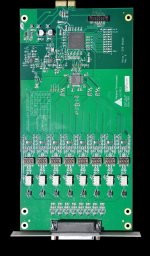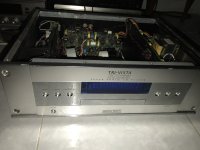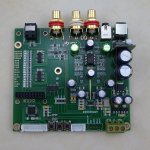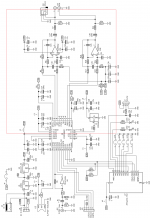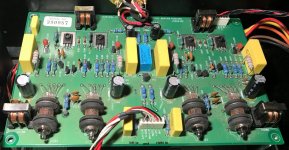And what about PMA's measurements? Naturally I have made quite a number of other measurements as well. And I trust my own measurements. Why don't you show some of your own measurements instead of always quoting others?
And as many commented on those threads it is all about implementation. LM4562 may be more susceptible for EMI/RF noise but proper implementation mitigates the issue.
And as many commented on those threads it is all about implementation. LM4562 may be more susceptible for EMI/RF noise but proper implementation mitigates the issue.
Last edited:
As we talked about before certain measurements can be useful for finding certain problems. If a problem shows up in a measurement, or maybe in more than one type of measurement, then its clear there is a problem (even if it just turns out to be a measurement problem). However if a particular measurement doesn't show a problem, doesn't mean there aren't any problems of a type that doesn't show up well in that particular measurement.
One thing makes me suspect LME49720 is less ideal than OPA1612 for I/V is from doing listening tests using them with ES9038Q2M. Another thing is that ESS and AKM both recommend OPA1612 where it matters the most. Why? LME49720 is lower cost and easier to get. Why not recommend it? Third thing is PMA did measurements showing LME49720/LM4562 doesn't like RF.
OTOH, an FFT measurement that looks for steady state HD when a DAC modulator is much more random than a pulsed RF source like PMA used, why would anyone expect the different tests show up in the same type of way on an FFT? Since a modulator is more or less random, however dac RF may be affecting an opamp probably looks like noise-like, not steady state. Maybe its ugly sounding signal-correlated noise with a big crest factor, who knows? What we do know is that large sample set FFT that has been averaged to minimize noise, that has had phase information discarded so crest factor is unknown, etc., possibly should be expected to hide some noise-like RF problem rather than expose it.
One thing makes me suspect LME49720 is less ideal than OPA1612 for I/V is from doing listening tests using them with ES9038Q2M. Another thing is that ESS and AKM both recommend OPA1612 where it matters the most. Why? LME49720 is lower cost and easier to get. Why not recommend it? Third thing is PMA did measurements showing LME49720/LM4562 doesn't like RF.
OTOH, an FFT measurement that looks for steady state HD when a DAC modulator is much more random than a pulsed RF source like PMA used, why would anyone expect the different tests show up in the same type of way on an FFT? Since a modulator is more or less random, however dac RF may be affecting an opamp probably looks like noise-like, not steady state. Maybe its ugly sounding signal-correlated noise with a big crest factor, who knows? What we do know is that large sample set FFT that has been averaged to minimize noise, that has had phase information discarded so crest factor is unknown, etc., possibly should be expected to hide some noise-like RF problem rather than expose it.
As I said already it is all about implementation. In my listening tests LM4562 worked better than OPA1612 with ES9038Q2M.
Pic below of an ESS based dac board that keeps the opamps well away from the digital stuff. Could conceivably be cleaner with that distance. A filter before the I/V might help some too. However MKHunt's dac board doesn't appear to be implemented like that. Is his dac implemented like yours?
Attachments
If you think it is about distance maybe you should measure the radiated EMI/RF of your dac with a RF field probe.
Actually, have measured with an E-field probe and spectrum analyzer. RF is everywhere inside the dac box. However, conducted RF from the dac outputs can be attenuated with distance using some kind of distributed filter. Have done that too, and found it can help.
Then I suggest you spend some time studying how to mitigate EMI/RF issues. There are better ways to achieve that instead of increasing distance or using OPA1612. But of course hacking boards made by others instead of designing them yourself seriously limits the options.
Here is my ES9038Q2M board powered with my LT30xx switching regulator board hanging directly above the dac and LM4562 with distance of less than 20mm (or 3/4 inch) component side to component side. Dac playing -100dBFS 1k signal. No averaging.

BTW no effort was made to shield the boards. All boards (DAC, ADC, PS, USB-I2S) were laying on my desktop directly in front of my LCD monitor.
BTW no effort was made to shield the boards. All boards (DAC, ADC, PS, USB-I2S) were laying on my desktop directly in front of my LCD monitor.
Last edited:
(1) The FFT says nothing about things like whether the soundstage is forward and narrow, or deep and wide. In other words, an FFT like that doesn't show some of ways that EMI/RFI can affect the sound.
(2) You didn't answer the question as to whether the dac being worked on by MKHunt is implemented enough like yours so that you can confidently recommend 4562 as being just as good or better than OPA1612 for his particular dac.
(2) You didn't answer the question as to whether the dac being worked on by MKHunt is implemented enough like yours so that you can confidently recommend 4562 as being just as good or better than OPA1612 for his particular dac.
Any studies that show how EMI/RFI affects sound?(1) The FFT says nothing about things like whether the soundstage is forward and narrow, or deep and wide. In other words, an FFT like that doesn't show some of ways that EMI/RFI can affect the sound.
Your previous argument was based on PMA's measurements. My measurements show no such issues and the soundstage is fine. But sorry to hear that your DAC is riddled with EMI/RFI.
As I see it you made general comments regarding OPA1612 and LM4562. Have you tested the exact same board that MKHunt has with both LM4562 and OPA1612?(2) You didn't answer the question as to whether the dac being worked on by MKHunt is implemented enough like yours so that you can confidently recommend 4562 as being just as good or better than OPA1612 for his particular dac.
Not having MKHunt board here I would suggest to follow the recommendation of ESS, the dac chip manufacturer.
Regarding the 'fine' soundstage, not sure I would rely on that claim. Regarding RFI/EMI have you ever measured emissions right at the top of a dac chip? An XMOS chip? CPLD? You don't see any clock edge harmonics emitted from anything at all?
Regarding the 'fine' soundstage, not sure I would rely on that claim. Regarding RFI/EMI have you ever measured emissions right at the top of a dac chip? An XMOS chip? CPLD? You don't see any clock edge harmonics emitted from anything at all?
Last edited:
Where is that recommendation to be found? ESS ES9038Q2M Socket board uses ADA4898.Not having MKHunt board here I would suggest to follow the recommendation of ESS, the dac chip manufacturer.
Sorry, I have learned not to rely on your claims about sound. Not using XMOS or CPLD. E.g. I2S signals are clean without any clock edge harmonics. While your dac suffers from RFI/EMI does not mean that properly designed dacs do as well.Regarding the 'fine' soundstage, not sure I would rely on that claim. Regarding RFI/EMI have you ever measured emissions right at the top of a dac chip? An XMOS chip? CPLD? You don't see any clock edge harmonics emitted from anything at all?
Okay, use that one then. For ES9038PRO the evaluation board uses OPA1611/1612.
DAC chips themselves directly emit radiated EMI/RFI of clock edge harmonics up into the hundreds of MHz if not higher. The emissions come right through the plastic QFP or whatever the case shape is. No way to stop it other than use a shield can or equivalent. Allo used shield cans over the clocks on Katana and Revolution dacs. Since they are measurement guys, they probably measured some benefit form doing that.
DAC chips themselves directly emit radiated EMI/RFI of clock edge harmonics up into the hundreds of MHz if not higher. The emissions come right through the plastic QFP or whatever the case shape is. No way to stop it other than use a shield can or equivalent. Allo used shield cans over the clocks on Katana and Revolution dacs. Since they are measurement guys, they probably measured some benefit form doing that.
Last edited:
Yes, I use shield cans on my LNA and oscillator. I have not yet found any reason (measurementwise or soundwise) to add them to my dacs or adcs. IME layout is the key to low EMI/RFI.
Just a little food for thought regarding the 9038Pro recommendation. 9038Q2M can output 4.XX mA per channel (2ch max) in current mode. 9038Pro can output 15mA per channel (8ch max) in current mode.
OPA1612 has over twice the current handling capability and is r2r out whereas LME is r2r none. Looking at another DAC I am intimately familiar with, the general topology is not that different. In fact, the ESS chip is even closer to the follower opamps than in the cheap DAC. There aren't even any metal electrolytic cans physically between the two.
DX7 Pro. 47920 voltage followers:

Multitone:

If I lived in a soundproof chamber and had never set foot outside, been on an airplane, ridden a motorcycle, etc then maybe. I do believe that the 47920 picks up RF; of that I have no doubt. I just don't believe it would cause oscillation (in this application) nor in-band audio problems at a real-world audible level as a voltage follower.
Regarding soundstage.... my DX7 Pro with 47920's as followers feeds my P308 MK2's in my PC listening space and soundstage is spooky. I have been tricked by background in a well-recorded video having a door that sounds like my entryway. Granted, that is a 9038Pro board; and it even uses AD8397 which looks like some unholy noise machine by OPA standards. But it sounds awesome and measures well below audibility.
If there is a problem down the line, it can be fixed easily.... when maybe SOIC-8 OPA1612's are in stock. But they literally cannot be purchased in the US from Digikey, Mouser, nor Newark right now. Even then, two of those is over 10% of the cost of the entire DAC. May as well pit Michelin Pilot Sport 4 S tires on a Geo Metro.
OPA1612 has over twice the current handling capability and is r2r out whereas LME is r2r none. Looking at another DAC I am intimately familiar with, the general topology is not that different. In fact, the ESS chip is even closer to the follower opamps than in the cheap DAC. There aren't even any metal electrolytic cans physically between the two.
DX7 Pro. 47920 voltage followers:
Multitone:
If I lived in a soundproof chamber and had never set foot outside, been on an airplane, ridden a motorcycle, etc then maybe. I do believe that the 47920 picks up RF; of that I have no doubt. I just don't believe it would cause oscillation (in this application) nor in-band audio problems at a real-world audible level as a voltage follower.
Regarding soundstage.... my DX7 Pro with 47920's as followers feeds my P308 MK2's in my PC listening space and soundstage is spooky. I have been tricked by background in a well-recorded video having a door that sounds like my entryway. Granted, that is a 9038Pro board; and it even uses AD8397 which looks like some unholy noise machine by OPA standards. But it sounds awesome and measures well below audibility.
If there is a problem down the line, it can be fixed easily.... when maybe SOIC-8 OPA1612's are in stock. But they literally cannot be purchased in the US from Digikey, Mouser, nor Newark right now. Even then, two of those is over 10% of the cost of the entire DAC. May as well pit Michelin Pilot Sport 4 S tires on a Geo Metro.
Please explain what that means to you. Thanks....measures well below audibility.
Dear Sirs,
I have a broken Musical Tri Vista SACD (bad DAC board & CD transport). Power board & tube buffer is good.
I bought DAC board ES9038q2m skysong from ebay.
I use Tri Vista's power source (+-15v) to connect the ES9038q2m
and ES9038q2m 's RCA output connected to tube buffer, sound is good but gain is small.
Please help me how to connect ES9038q2m -> buffer to increase gain or make the sound
Thanks
I have a broken Musical Tri Vista SACD (bad DAC board & CD transport). Power board & tube buffer is good.
I bought DAC board ES9038q2m skysong from ebay.
I use Tri Vista's power source (+-15v) to connect the ES9038q2m
and ES9038q2m 's RCA output connected to tube buffer, sound is good but gain is small.
Please help me how to connect ES9038q2m -> buffer to increase gain or make the sound
Thanks
Attachments
new LDOs and 47920s are in. Sweet. That saved me a lot of money on a power supply. Noise across LDO OP cap shown below. I can live with 2.4mV ripple. I broke down and wound a little ground clip spring on the lathe and baked it to set the spring form. AC coupling, 20MHz BW limit, 1x scope and probe gain.

Dear Sirs,
I have a broken Musical Tri Vista SACD (bad DAC board & CD transport). Power board & tube buffer is good.
I bought DAC board ES9038q2m skysong from ebay.
I use Tri Vista's power source (+-15v) to connect the ES9038q2m
and ES9038q2m 's RCA output connected to tube buffer, sound is good but gain is small.
Please help me how to connect ES9038q2m -> buffer to increase gain or make the sound
Thanks
Swap these to 3.3k and you can get about 20-40% more output.
If that is not enough then you can also also swap the 8.2k resistors for 10k or 13.7k units. You will not get more out of a 15V bipolar supply.
But if you have an RMS multimeter, I would measure the present output because it is probably already a little spicy.
SIm output using max values on 9038Q2m datasheet.
- Home
- Source & Line
- Digital Line Level
- ES9038Q2M Board
